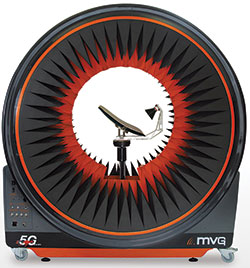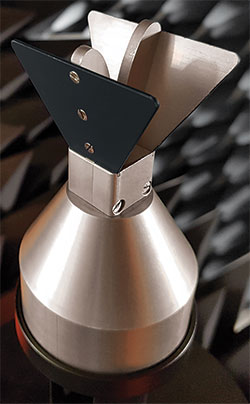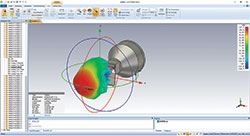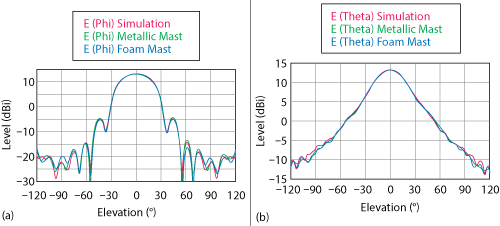
Soon, the arrival of 5G will lay the foundation for a hyper-connected society: a world in which everything that benefits from being connected will be connected. Internet connections will move from computer and smartphone screens to a world of objects communicating directly among themselves. All sectors of society will be transformed by this technology, from Industry 4.0, with smart factories; to the automobile industry, with self-driving cars; to the healthcare sector, with remotely controlled robotic surgical procedures; to connected homes and smart cities. Indeed, 5G will enable wireless connectivity in a wide range of markets and industries, going far beyond what has been done with LTE.
During development, the technology required to realize 5G will be put to the test—literally. To address this challenge, MVG has developed the StarLab 50 GHz, which the company says reinvents high frequency antenna and over-the-air (OTA) performance testing. Delivering ultra-fast and accurate test results, StarLab 50 GHz provides a future-proof, turnkey solution for high frequency system development, meeting the 5G testing challenge.
5G CHALLENGES

Figure 1 The SH 4000 dual ridge horn antenna, used as a test case for the StarLab 50 GHz.
5G is based on three cornerstones. The first is an increase in bandwidth and network capacity to transmit greater quantities of data to an increasingly large number of users. The second is ultra-reliable wireless connections with low latency, allowing critical real-time applications to function securely, such as self-driving cars and remote surgery. The last is wireless connectivity that requires little bandwidth and energy to prepare for the extensive deployment of connected objects, such as sensors. By making permanent connections possible, the arrival of 5G will be accompanied by the large-scale usage of cloud computing, which will make it possible to efficiently operate many new services. The success of many of these services will depend on wireless connection quality. Wireless connection performance will be a parameter that is difficult to control, as it is based on the quality of the networks deployed and the specific implementation of wireless connectivity solutions in the device.
To verify performance, tests and measurements of devices and 5G network equipment must be conducted, differing considerably from what is done currently. 5G will, in addition to using the frequency ranges used in current cellular networks, use higher frequency bands where the hardware will not have physical connectors. In these cases, products will be tested exhaustively in wireless mode (OTA); traditionally, many tests are conducted in wired mode. This will lead to an ever-increasing number of scenarios and test cases requiring OTA testing to ensure both compliance with standards and good user experience in real-life applications.
Beyond these technical challenges, there are others related to convenience and the ease-of-use of the test system. Large anechoic chambers traditionally need dedicated infrastructure, with extensive real estate and building construction. As a convenient and flexible alternative, MVG has created a series of compact, portable, all-in-one antenna measurement tools called “Little Big Lab,” that adheres to the motto “Little in size, BIG in performance.”
THE SOLUTION
The StarLab 50 GHz is the latest innovative addition to MVG’s product range. It is designed to meet high frequency testing challenge and is based on the combined knowhow of the company, from telecom OTA testing to aerospace and defense high frequency testing. Because it is compact and portable, the StarLab 50 GHz frees up space in laboratories and production environments and saves costs.

Figure 2 Simulation of the SH 4000 using CST MWS.
With its ultra-fast, electronically-scanned probe array—testing 10x faster than standard ones—it is ideal for mmWave antenna measurement and OTA testing. Accuracy is enhanced thanks to its capability to measure with limited movement, owing to patented oversampling technology. Its spherical configuration enables all types of antenna measurements, from low to high directivity. This 50 GHz version has been designed with a keen sense of detail in every component: wedge absorbers optimized to minimize reflections; cutting-edge probes that are wideband (18 to 50 GHz), low directional and dual-polarized; and accurate stabilizers, offering stability and fine level adjustment.
ANTENNA TEST CASE
To illustrate the capability of the StarLab 50 GHz, the following test case evaluates an MVG SH 4000, a dual ridge horn antenna (see Figure 1), which is typically used as a gain reference in test ranges and as a reflector feed for high gain applications in compact ranges. It is the reference antenna in the 30 GHz antenna test case described here. The simulation of the antenna radiation pattern is performed with the CST MWS simulation software (see Figure 2), with only the antenna included in the simulation model. The interface on which the antenna is installed and the cable that feeds it are not included in the simulated results, though they will have an influence on the actual antenna performance. Despite this, good correlation is shown between the simulation and the measurements performed with StarLab 50 GHz.

Figure 3 Simulation vs. measurement of the SH 4000 at 30 GHz, with phi = 0° (a) and 90° (b).
Figure 3 shows a comparison between the measured and simulated radiation patterns, with phi = 0 and 90 degrees. One measurement was realized with a metal mast, which offers better positioning precision but impacts the radiation pattern. The second measurement was performed with a foam mast, which provides less mechanical positioning accuracy but limits the impact on the radiation pattern, since the foam is electrically transparent at the measured frequencies. For both measurements, the curves of the simulated and measured antennas correlate well. This demonstrates that the results measured with the StarLab 50 GHz are accurate, and the fast, multi-probe concept can be applied successfully to high gain, high frequency antenna testing. In this case, the performance at 30 GHz is particularly relevant for 5G. At high frequencies, the 5G new radio (NR) will initially be rolled out and deployed in the 24 to 30 GHz frequency range, depending on the region.
MVG
Paris, France
www.mvg-world.com/en
